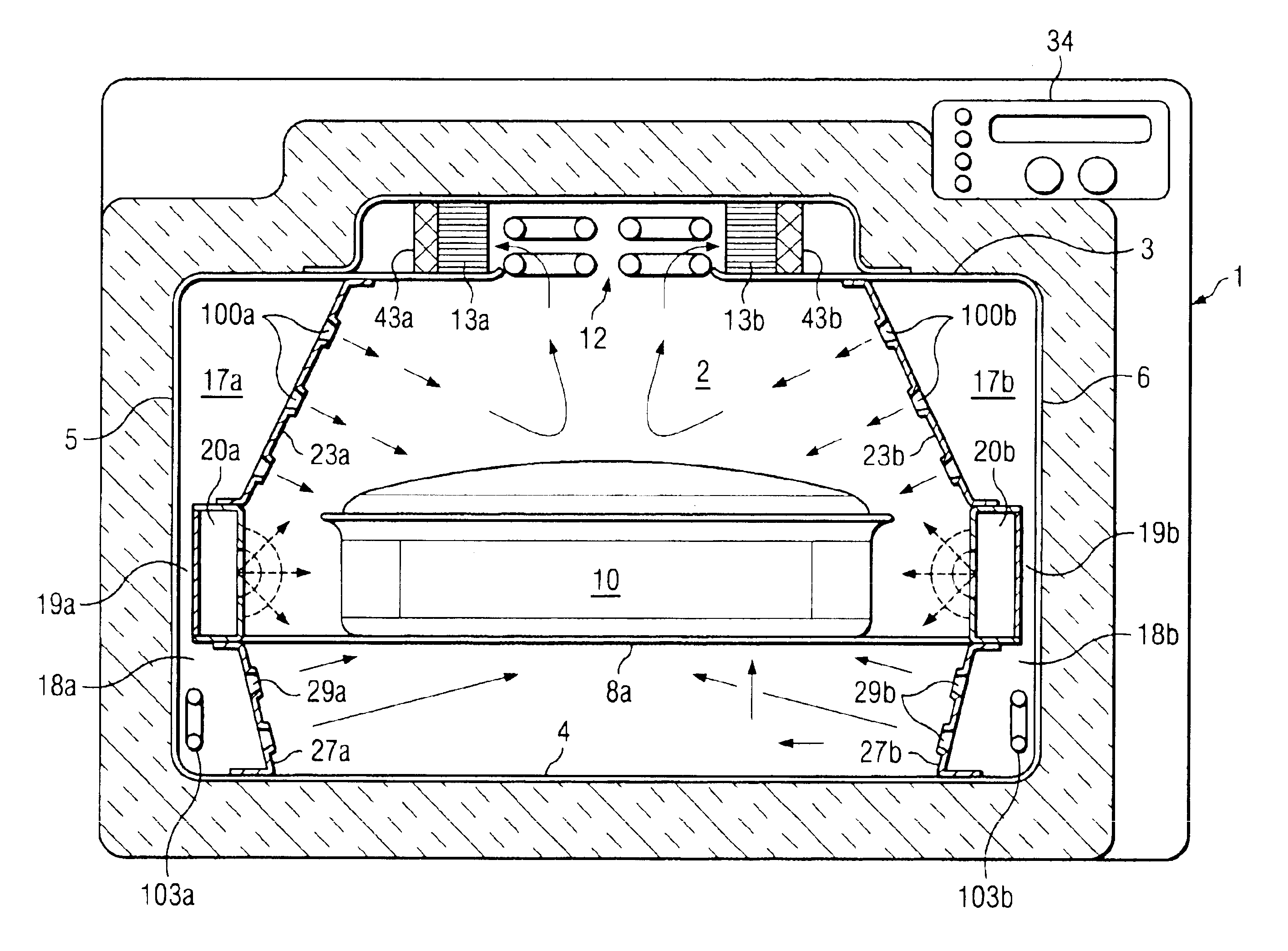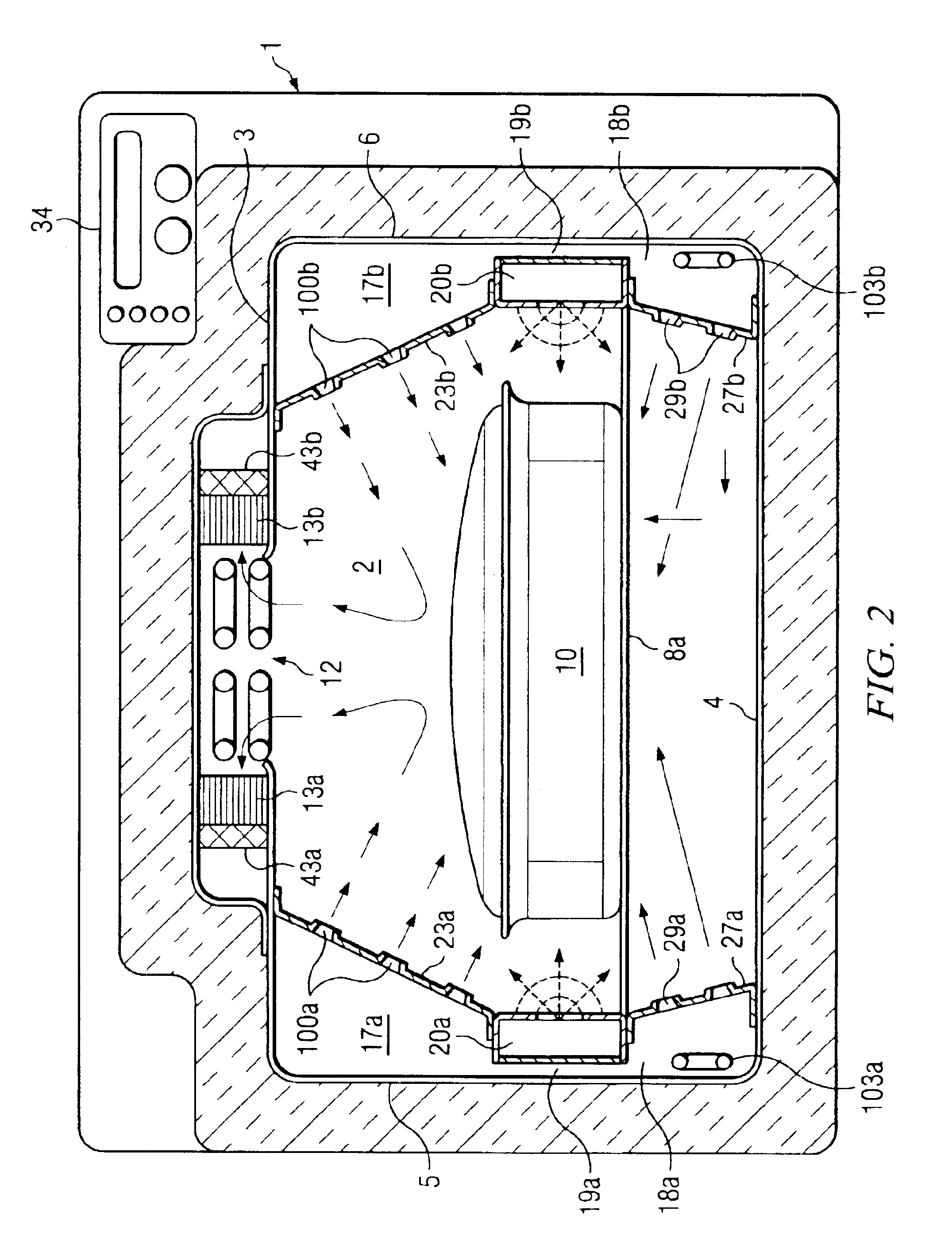This process is inefficient, but people have nevertheless developed the
skill level necessary to overcome the inefficiencies of the method.
Shipping costs, packaging costs, shelf space in grocery stores and many other areas of the food production
system and delivery chain will be impacted as the world of
food preparation, storage, transportation, delivery, preparation and sale moves from conventional cooking to speed cooking.
In general, these designs have a number of limitations and drawbacks.
The first limitation is that the
microwave launch
system cannot equally illuminate multiple racks or pans of food.
In addition to the
microwave energy field non-uniformity, the
convection air flow also has non-uniform behavior which results in lower air flow rates in the oven limiting the
convection heat transfer rate, thereby limiting the cooking speed of the oven.
The center pan often has a distinctive “V” cooking pattern near the blower inlet and this creates flow non-uniformity from the center rack position to the top / bottom positions.
Balancing the air flow over several pans or cooking vessels is difficult as the air is drawn to the center of the back wall.
As discussed herein, imparting high air flows to the oven in order to achieve high cook speeds results in non-uniform cooking.
The effectiveness of this approach is limited, and in general the oven air flow rates are maintained at modest rates.
In addition to the drawbacks described above relative to cooking speeds, these oven designs do not manage or
handle air borne
grease entrained by the
convection air and by health code, these ovens must be operated under a hood when cooking meats or other
grease laden foods.
They have some speed
advantage, but are not fast enough to radically change the cooking operation in a restaurant, commercial establishment or the home kitchen.
A number of developments have taken place to create high speed commercial cooking ovens in the 3-10 times faster than conventional range, but fundamental drawbacks exist in these high speed commercial ovens and approaches.
These ovens cook at high speed but some do not provide a quality finished food product.
These ovens tend to be complex, unreliable and expensive to manufacture.
As such, the finished sales price is high, thereby limiting the demand for, and commercial success of the ovens.
Due to the state of the art of these high speed commercial cooking machines, the oven cavities tend to be small, they create
smoke and
odor, and therefore require expensive ventilation or catalytic clean-up.
They are generally difficult to maintain, generally employ the use of a complex
user interface with multiple control variables, and generally require large power supplies.
They also tend to be less reliable due to the use of specialized components.
Several high speed cooking ovens featuring impingement style
convection flow fields coupled with microwave energy have been developed and impingement style
heat transfer is not new in the art.
While this approach produces high cooking speeds (5-10 times faster than conventional oven) it has several limitations as the ovens have non-uniform energy fluxes (convection and microwave) between the top and bottom of the food product thereby requiring complex control of the microwave and convection heating systems (sub-systems) to achieve speed cooking.
These devices are expensive and dramatically add to the complexity and cost of the final product.
Additionally, these sub-systems tend to be unreliable, causing high service callouts.
To achieve high speed the ovens require a relatively complex and expensive variable speed convection blower
motor speed control with dynamically braking blower
motor speed controllers and sophisticated electronic oven controls.
These ovens also have a lack of independent top side and bottom side convection (
browning) heating because top impingement flow must
wrap around the food product and flow under the food product in order to accomplish bottom side heating /
browning.
This requires the use of the previously mentioned expensive, fragile, and difficult to clean microwave transparent
ceramic platter, which allows for the passage of microwaves.
The
ceramic platter is expensive to manufacture, chips easily (creating health, performance and reliability problems) and requires regular cleaning, maintenance, and replacement.
Indeed, ovens utilizing these
ceramic platters have met with difficulty when introduced into commercial establishments with the prospective owners of these ovens constantly battling reliability problems and the need to re-supply their commercial establishments with ceramic platters.
As water, for example is absorbed within these platters, microwave performance decreases because the microwave energy interacts or couples with the water molecules (the principle of a
microwave oven is the excitation of the
oxygen-
hydrogen bond within the water molecule) thereby reducing the microwave energy available for cooking.
For this reason, a speed cooking oven requiring the use of a ceramic platter with apertures to both direct air flow and exhaust air flow is undesirable, but is nevertheless necessary as the described oven utilizes the “shroud” or “wrap” effect in order to fully and somewhat properly cook the food product; and the shroud effect is only created by the wrapping of the air around the food product via use of the ceramic platter.
Also, with the requirement of very rapid air circulation through the oven (
high velocity impingement), these ovens tend to be noisy.
A common result of this requirement is that there is a lack of uniformity; so it is necessary to
restrict or reduce the cooking zone to that area that experiences appropriate cooking, relative to the platter.
This reduces the cooking capacity for a given oven
cavity size because less of the platter can be cooked upon.
Especially lacking in these ovens is the ability to cook in the corner sections of the oven.
With other technologies, means to overcome this problem are complex and have at least partially been solved by rotation of the food product under air jets with the use of a turntable.
Using rotation (turntable) to compensate for jet non-uniformity also has the effect of reducing the useful cooking area of the appliance by at least approximately 25%.
In addition to the previously mentioned drawbacks of the ceramic platter, the platter further complicates the ability to achieve uniform flow conditions because the vertical jet air flow pattern couples to the ceramic platter which is being used to channel flow under the food.
Additionally, the non-uniformity is a function of the shape and size of any cooking vessel used (e.g. pan, cookie sheet) because the air flow must
wrap around the cooking vessel.
In addition to the problems associated with these other oven cavity bottoms, the design and construction of the oven cavity top is complex given the need to add or modify the oven cavity roof for impingement
nozzle plates / supply ducts.
Another
disadvantage in the previously described oven is that it is difficult to provide a microwave seal to the cavity floor (microwave launches through the oven floor through a
circular waveguide) to prevent grease / liquid
contamination of the wave guides.
In these ovens, an opening in the oven cavity floor bottom allows the microwave launcher to extend up and through the oven cavity floor but the launcher must be sealed with a material that allows the passage of microwave energy, without any leakage of the seal because leakage of the seal then allows grease,
food products and other by-products of the
cooking process to contaminate the microwave launching
system, thereby reducing the life of the microwave system, causing again, as described above, tube failure and service callouts.
Another
disadvantage of the high speed ovens described above is that they require grease control because of the
high velocity of the impinging air jets.
Drawbacks of the catalyst include its high cost and the catalyst tends to cause a pressure drop in the impingement air flow, thereby reducing operating efficiencies.
The pressure drop is compensated by the use of a larger blower, thereby increasing component cost and lowering operating efficiencies and raising energy costs.
The catalysts must be replaced periodically, adding both a service cost and an equipment cost to the oven.
First, the floor located gas
nozzle plate and its supply duct are very difficult to maintain given their susceptibility to food spoils, spills and grease accumulation. To utilize the entire (or nearly) cooking area (rack), the top and bottom air jets must be very uniform in velocity or a non-uniform cooking and
browning of the food product will result where the impingement jets produce circular brown spots on the food product surface. This polka dot browning effect is, of course generally not acceptable. Additionally, the requirement for very uniform gas flow to the food product adds complexity to the air flow system.
Second, uniform air jet fields are difficult to achieve at flows other than the
design flow rates. When lower air flow rates (velocities) are needed, such as with pastries, it is difficult to attain proper air flow rates less than the
design flow rate specified for higher air flows. Such reduced flows will minimize the effective cooking area within the oven cavity to a portion of the cavity where a reasonable flow field exits in order to cook a food product to an acceptable
quality level. Alternatively, to compensate for the requirement of a less aggressive air flow, the convection flows must be greatly reduced, which will result in longer cook times (defeating the desire for a speed cooking oven).
Third, the general oven construction is complex, as the supply duct to the roof air plate must also act as a launch box for the microwaves. This requires that the roof jet plate be transparent to microwaves (e.g., ceramic plate with jet holes) so that the microwaves can be launched through the plate. Additionally, the floor ducts may become complex parts in the event they are designed to be removed for cleaning and / or servicing.
Fourth, having supply ducts on the floor and roof of the oven cavity greatly reduces the useful volume (cook section) of the oven because as much as half of the height of the oven cavity is occupied by these air channels. Other techniques have been used in an attempt to overcome these issues, but these techniques generally require more complexity such as oscillating nozzles, rotating food support, special food containers, and a smaller cook section and the work arounds tend to add complexity, cost and create other undesirable issues.
Impingement style air flow is ineffective with two or more rack positions because one rack with food product will block air flow to the second or third rack.
It will be difficult for speed cooking ovens to become popular within either the commercial foodservice marketplace or within the residential market unless quality speed cooking utilizing
metal pans can be accomplished.
Another problem generally encountered is that browning of the lower surface of the food product is difficult to control because the method generally utilized for bottom side browning is conduction through a
metal pan (pan is heated by radiant or microwave energy and then the thermal is transferred to the food product by direct contact with the food product) and this heating produces a griddle effect, thereby browning the bottom side of the food product.
This method is difficult to control and generally produces an over brown or burned bottom surface of the food product.
 Login to View More
Login to View More  Login to View More
Login to View More 


